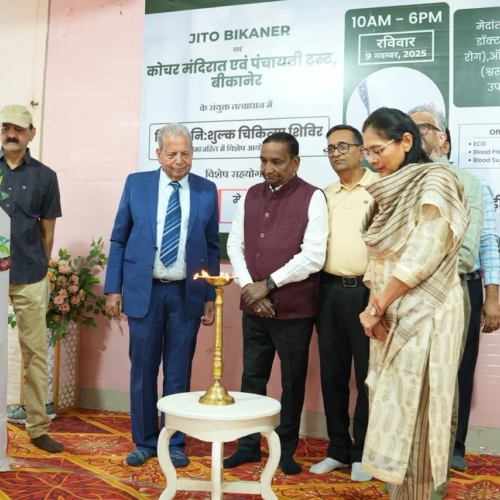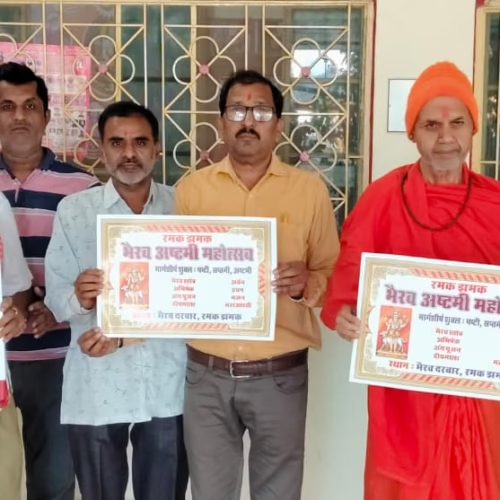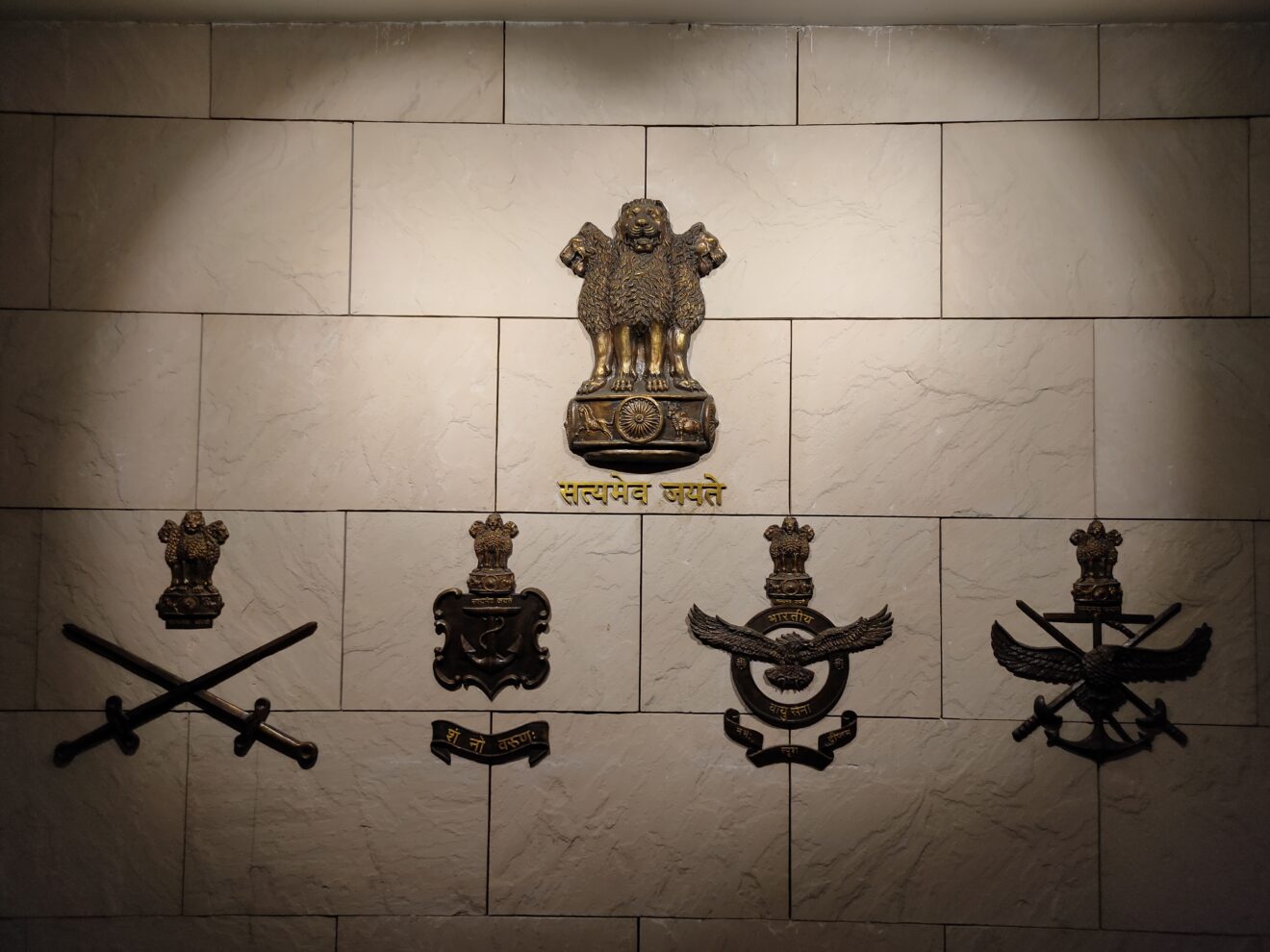BY DEFENCE JOURNALIST SAHIL | T.I.N. NETWORK
Forging Strength Through Synergy: Southern Command’s Exercise Akhand Prahar Showcases India’s Multi-Domain Battle Readiness
Jaisalmer
In the arid expanse of Rajasthan’s desert ranges, where the golden sands meet the steel of India’s military might, the Southern Command of the Indian Army demonstrated its evolving prowess in multi-domain operations through Exercise Akhand Prahar — a high-intensity field manoeuvre forming a vital component of the larger Tri-Services exercise Trishul.
The exercise, conducted under the aegis of the Konark Corps, was reviewed by Lieutenant General Dhiraj Seth, PVSM, AVSM, General Officer Commanding-in-Chief, Southern Command. His presence at the battlefield was both symbolic and strategic — reaffirming India’s focus on synergy, technology infusion, and the jointness of its Armed Forces in preparing for future conflicts that demand coordination across air, land, and digital frontiers.
Integration, Innovation, and Atmanirbharta at the Core
The essence of Exercise Akhand Prahar lay not merely in the movement of tanks, aircraft, and artillery but in the orchestration of multiple combat domains — physical, informational, and technological — in perfect harmony. The drill validated the Indian Army’s capacity to execute integrated, multi-domain operations alongside the Indian Air Force, blending mobility, precision, and real-time intelligence.
The Army Commander witnessed Combined Arms manoeuvres that highlighted seamless inter-service coordination between ground formations, attack helicopters, and fighter aircraft. This high-level integration between the Battle Axe Division and the Konark Corps underlined India’s ability to deliver decisive combat outcomes through synergy rather than scale.
These operations were supported by next-generation battlefield technologies, including drone-based reconnaissance, counter-UAS systems, AI-assisted targeting solutions, and advanced sensor-fusion platforms — all reflecting the Indian Army’s determined stride towards Atmanirbharta (self-reliance) and indigenisation in defence technology.
A Testbed for Indigenous Innovation
A standout feature of Exercise Akhand Prahar was the live field evaluation of indigenously developed innovations from formation-level workshops and Indian defence start-ups. The Battle Axe Division presented an impressive array of indigenous drones, counter-drone systems, mobile command units, and smart surveillance tools designed to enhance tactical awareness in high-threat zones.
These innovations were not imported or laboratory-tested prototypes — they were battlefield-ready, conceptualised and engineered by the Indian Army’s own innovators in collaboration with academia and private partners under the “Innovation for Defence Excellence” (iDEX) and “Atmanirbhar Bharat” initiatives.
Lt Gen Dhiraj Seth personally interacted with soldiers, technical teams, and young innovators behind these projects, appreciating their ingenuity, adaptability, and courage to experiment under live combat conditions.
From the Desert to the Future: Validating Joint Warfighting Concepts
Exercise Akhand Prahar served as a real-time proving ground for validating Joint Warfighting Concepts under the Tri-Services framework. The participating units simulated complex battlefield situations — including enemy air intrusions, precision strikes, cyber-electronic disruptions, and rapid response manoeuvres — to refine operational synergy between the Indian Army and Air Force.
The exercise demonstrated how Integrated Battle Groups (IBGs) and networked command systems can act as the backbone of India’s future-ready fighting force, allowing swift decision-making across hierarchies and service boundaries. The combined use of attack helicopters, fighter aircraft, artillery, and mechanised infantry displayed the Army’s ability to adapt to evolving conflict scenarios across multiple domains simultaneously.
Lt Gen Dhiraj Seth commended the formations for their high standards of operational readiness, disciplined execution, and innovative spirit. His words resonated with the Indian Army’s core philosophy — that modern conflicts are won not merely by weapons, but by the will and wisdom of those who wield them in unison.
Battle Axe Division: The Vanguard of Technological Adaptation
Known for its historic valour and operational excellence, the Battle Axe Division continues to remain at the forefront of India’s Western Front preparedness. During the exercise, the division showcased a series of battlefield innovations conceptualised at the unit level — including portable counter-drone jammers, AI-driven surveillance nodes, and tactical communication systems designed to sustain connectivity even under electronic warfare stress.
Such innovations, when combined with the Konark Corps’ deep-strike and manoeuvre capabilities, exemplify how field formations under the Southern Command are evolving into smart, adaptive combat entities capable of operating independently or as part of larger tri-service task forces.
The Tri-Service Context: Trishul as a Template for Future Conflict
The inclusion of Exercise Akhand Prahar within the broader Tri-Service Exercise Trishul carries deep strategic meaning. Trishul represents India’s vision of Integrated Warfighting, where the Army, Navy, and Air Force do not function as parallel entities but as synchronised instruments of national power.
Within this framework, Akhand Prahar served as the Army-Air Force operational link — demonstrating how ground manoeuvres and aerial dominance can coalesce to deliver precise, time-sensitive effects on the modern battlefield.
The participation of Indian Air Force elements, including rotary-wing and fixed-wing assets, allowed for live validation of joint tactics, such as heliborne assaults, deep-strike coordination, and air-delivered logistics. These joint manoeuvres underscore India’s growing emphasis on multi-domain awareness, real-time data sharing, and unified command structures.
Leadership, Vision, and the JAI Doctrine
In his address to troops, Lt Gen Dhiraj Seth lauded the men and women of the Southern Command, Konark Corps, and Battle Axe Division for their dedication, professionalism, and adaptability. He reiterated that the Indian Army’s modernisation and operational reforms are deeply anchored in the JAI mantra — Jointness, Atmanirbharta, and Innovation.
He noted that the strength of modern warfare lies not in numbers but in integration, where the synergy of human skill, indigenous technology, and strategic foresight forms the bedrock of national security. “The Indian Army,” he emphasised, “is committed to transforming from a platform-centric force to a networked, knowledge-driven, and technology-enabled combat organisation — one that can dominate across all domains.”
Southern Command: Leading the Transformation
Under the visionary leadership of Lt Gen Dhiraj Seth, the Southern Command has been instrumental in pioneering operational innovation, doctrinal experimentation, and civil-military synergy. The command’s operational reach spans from the deserts of Rajasthan to the coastal sectors, making it a crucial link in India’s western and southern defensive arc.
Exercises like Akhand Prahar highlight the command’s continuous efforts to train, transform, and test — ensuring that every soldier and system is battle-ready in an era defined by rapid technological evolution and hybrid threats.
Towards Future Conflicts: A Nation in Motion
In its deeper essence, Exercise Akhand Prahar is not just a military drill — it is a statement of intent. It signals India’s resolve to anticipate, adapt, and act in an increasingly unpredictable security environment.
Through its emphasis on multi-domain integration, indigenous innovation, and jointness, the exercise reaffirms the Indian Army’s unwavering focus on building a force that is as modern as it is moral, as technological as it is tenacious.
As the sun sets over the desert sands of Jaisalmer, the echoes of Akhand Prahar carry a singular message — India’s strength lies not only in its soldiers, but in the synergy that unites them.
BY DEFENCE JOURNALIST SAHIL | T.I.N. NETWORK
सामंजस्य से सशक्त राष्ट्र रक्षा — दक्षिणी कमान का ‘अखंड प्रहार’ अभ्यास दिखा रहा है भारत की बहु-क्षेत्रीय युद्ध क्षमता का नया युग
जैसलमेर
राजस्थान के तपते रेगिस्तान में, जहां रेत की लहरें भारतीय सैनिकों की दृढ़ता से टकराती हैं, वहीं भारतीय सेना की दक्षिणी कमान ने अपनी अभूतपूर्व युद्ध तैयारी और तकनीकी क्षमता का प्रदर्शन किया। एक्सरसाइज़ ‘अखंड प्रहार’ के नाम से आयोजित यह सैन्य अभ्यास त्रि-सेवा अभ्यास ‘त्रिशूल’ का एक महत्वपूर्ण हिस्सा था, जिसने भारत की आधुनिक युद्ध अवधारणा — संयुक्तता, आत्मनिर्भरता और नवाचार (JAI) — को जीवंत रूप में प्रस्तुत किया।
यह अभ्यास कोणार्क कोर के तत्वावधान में संपन्न हुआ, जिसकी समीक्षा लेफ्टिनेंट जनरल धीरज सेठ, PVSM, AVSM, जनरल ऑफिसर कमांडिंग-इन-चीफ, दक्षिणी कमान ने की। उनकी मौजूदगी मात्र निरीक्षण नहीं थी, बल्कि एक रणनीतिक संदेश थी — कि भारत की सेनाएं अब केवल सामरिक शक्ति नहीं, बल्कि संयुक्त युद्धक्षेत्र में तालमेल और तकनीकी एकीकरण की मिसाल बन चुकी हैं।
संयुक्तता, नवाचार और आत्मनिर्भरता — अभ्यास का मूल मंत्र
‘अखंड प्रहार’ का सार केवल टैंकों की गरज या विमानों की उड़ान में नहीं था, बल्कि उन सभी माध्यमों के एक साथ संचालन में था जो आधुनिक युद्ध के तीन आयामों — स्थल, वायु और तकनीक — को जोड़ते हैं।
इस अभ्यास ने यह सिद्ध किया कि भारतीय सेना अब एक ऐसी संगठित शक्ति है जो वास्तविक समय में भारतीय वायुसेना के साथ इंटीग्रेटेड मल्टी-डोमेन ऑपरेशन को अंजाम दे सकती है।
सेना प्रमुख ने संयुक्त बल संचालन का सजीव प्रदर्शन देखा, जिसमें बैटल ऐक्स डिवीजन और कोणार्क कोर के दस्ते वायुसेना के फाइटर जेट्स और अटैक हेलीकॉप्टरों के साथ सटीक तालमेल में कार्य कर रहे थे। इस स्तर की इंटर-सर्विस कोऑर्डिनेशन ने यह स्पष्ट किया कि आधुनिक युद्ध अब केवल संख्या नहीं, बल्कि सामंजस्य से जीता जाता है।
अभ्यास में उपयोग हुई अगली पीढ़ी की सैन्य तकनीकें — जैसे कि ड्रोन आधारित निगरानी, काउंटर-यूएएस सिस्टम, एआई समर्थ लक्ष्य प्रणाली और सेंसर-फ्यूजन प्लेटफॉर्म — भारत की आत्मनिर्भरता (Atmanirbharta) की दिशा में एक ठोस कदम हैं।
नवाचार की प्रयोगशाला — मैदान में उतरे स्वदेशी समाधान
‘अखंड प्रहार’ की सबसे विशिष्ट उपलब्धि रही स्वदेशी नवाचारों का लाइव फील्ड मूल्यांकन। बैटल ऐक्स डिवीजन ने अपने अभियानों में ऐसे उपकरण प्रस्तुत किए जो भारतीय सैनिकों द्वारा स्वयं विकसित किए गए थे — स्वदेशी ड्रोन, काउंटर-ड्रोन सिस्टम, मोबाइल कमांड यूनिट्स और स्मार्ट सर्विलांस टूल्स, जो खतरनाक युद्धक्षेत्रों में सामरिक जागरूकता बढ़ाने में सक्षम हैं।
ये सिर्फ प्रयोगशाला के मॉडल नहीं थे, बल्कि युद्ध के लिए तैयार समाधान थे — भारतीय सेना के भीतर के नवोन्मेषकों, शैक्षणिक संस्थानों और निजी उद्योगों के सहयोग से विकसित। यह भारत के iDEX (Innovation for Defence Excellence) और आत्मनिर्भर भारत अभियानों की जीवंत झलक थी।
लेफ्टिनेंट जनरल धीरज सेठ ने खुद उन सैनिकों और युवा इंजीनियरों से संवाद किया जिन्होंने ये तकनीकें विकसित की थीं। उन्होंने उनकी नवोन्मेषी सोच, अनुकूलन क्षमता और जोखिम उठाने की भावना की प्रशंसा की।
रेगिस्तान से भविष्य तक — संयुक्त युद्ध अवधारणाओं की पुष्टि
यह अभ्यास केवल एक प्रदर्शन नहीं था, बल्कि एक वास्तविक युद्ध प्रयोगशाला थी। इसमें प्रतिभागी यूनिट्स ने संयुक्त युद्ध सिद्धांतों (Joint Warfighting Concepts) को व्यवहार में परखा।
युद्ध परिदृश्य में वायु घुसपैठ, सटीक हमले, साइबर-इलेक्ट्रॉनिक व्यवधान, और तेज़ प्रतिक्रिया अभियानों की स्थिति को दोहराया गया, ताकि सेना और वायुसेना के बीच वास्तविक समय में संचालन की संगति को परखा जा सके।
यह भी प्रदर्शित किया गया कि इंटीग्रेटेड बैटल ग्रुप्स (IBGs) और नेटवर्क-सक्षम कमांड सिस्टम भविष्य के युद्धों में भारतीय सेना की रीढ़ साबित होंगे। इनसे न केवल आदेश प्रणाली तेज़ होगी, बल्कि भूमि और वायु की संयुक्त कार्रवाइयों में घातक सटीकता सुनिश्चित होगी।
लेफ्टिनेंट जनरल धीरज सेठ ने अभ्यास में भाग लेने वाले सभी सैनिकों की उच्च तैयारी, अनुशासन और नवाचार भावना की सराहना की। उनके शब्द भारतीय सेना के मूल सिद्धांत को दोहराते हैं — “युद्ध हथियारों से नहीं, बल्कि उन योद्धाओं की एकता और बुद्धिमत्ता से जीते जाते हैं जो उन्हें संभालते हैं।”
बैटल ऐक्स डिवीजन — तकनीकी रूपांतरण का अग्रदूत
भारत की पश्चिमी सीमाओं पर हमेशा अग्रिम पंक्ति में रहने वाली बैटल ऐक्स डिवीजन ने इस अभ्यास में फिर एक बार अपनी पहचान मजबूत की। डिवीजन ने युद्धक्षेत्र के लिए विकसित अनेक नवाचार प्रस्तुत किए — पोर्टेबल काउंटर-ड्रोन जैमर, एआई-आधारित सर्विलांस सिस्टम, और टैक्टिकल कम्युनिकेशन नेटवर्क, जो इलेक्ट्रॉनिक युद्ध की स्थिति में भी कनेक्टिविटी बनाए रखते हैं।
जब ये नवाचार कोणार्क कोर की गहरी प्रहार क्षमता के साथ संयोजित हुए, तब यह साफ हुआ कि दक्षिणी कमान के फील्ड फॉर्मेशन अब स्मार्ट, अनुकूलनशील और आत्मनिर्भर युद्ध बलों में परिवर्तित हो चुके हैं।
त्रिशूल — भविष्य के युद्ध की रूपरेखा
अखंड प्रहार का त्रि-सेवा अभ्यास त्रिशूल के भीतर शामिल होना अपने आप में एक गहरा सामरिक संदेश देता है। यह भारत की उस सैन्य सोच को प्रकट करता है, जिसमें थल, जल और नभ तीनों सेनाएं एक साझा मिशन के तहत एकजुट होकर काम करती हैं।
इस परिप्रेक्ष्य में ‘अखंड प्रहार’ ने थल सेना और वायुसेना के बीच ऑपरेशनल लिंक के रूप में कार्य किया। इससे यह प्रदर्शित हुआ कि जमीनी युद्धाभ्यास और वायु प्रहारों को मिलाकर सटीक और त्वरित परिणाम प्राप्त किए जा सकते हैं।
भारतीय वायुसेना के हेलीकॉप्टरों और लड़ाकू विमानों ने संयुक्त अभियानों में भाग लिया — जिसमें हेलीबोर्न ऑपरेशन, डीप-स्ट्राइक कोऑर्डिनेशन और एयर-लॉजिस्टिक सपोर्ट जैसे मिशन शामिल थे। इससे भारत की सेनाओं के बीच डेटा साझाकरण, संयुक्त निर्णय प्रणाली और यूनिफाइड कमांड स्ट्रक्चर की दिशा में प्रगति प्रदर्शित हुई।
नेतृत्व और विज़न — JAI मंत्र की व्याख्या
सैनिकों को संबोधित करते हुए लेफ्टिनेंट जनरल धीरज सेठ ने दक्षिणी कमान, कोणार्क कोर और बैटल ऐक्स डिवीजन के सैनिकों की समर्पण भावना, तकनीकी दक्षता और प्रोफेशनलिज़्म की प्रशंसा की। उन्होंने कहा कि भारतीय सेना के आधुनिकीकरण और संचालन सुधार का मूल आधार है — JAI मंत्र: Jointness, Atmanirbharta और Innovation।
उन्होंने स्पष्ट कहा — “आधुनिक युद्ध संख्या या ताकत से नहीं, बल्कि समन्वय से जीता जाता है। मानव कौशल, स्वदेशी तकनीक और रणनीतिक दृष्टिकोण का समन्वय ही राष्ट्रीय सुरक्षा की सच्ची नींव है।”
उन्होंने यह भी जोड़ा कि भारतीय सेना एक प्लेटफॉर्म-सेंट्रिक संगठन से अब नेटवर्क-सक्षम और ज्ञान आधारित युद्धबल में रूपांतरित हो रही है — जो हर युद्धक्षेत्र में प्रभुत्व स्थापित कर सके।
दक्षिणी कमान — रूपांतरण की दिशा में अग्रणी
लेफ्टिनेंट जनरल धीरज सेठ के नेतृत्व में दक्षिणी कमान ने हाल के वर्षों में ऑपरेशनल इनोवेशन, डॉक्ट्रिनल प्रयोग और सिविल-मिलिट्री सामंजस्य के क्षेत्र में अग्रणी भूमिका निभाई है। इसकी रणनीतिक पहुंच राजस्थान के रेगिस्तानों से लेकर समुद्री तटों तक फैली है, जो इसे भारत की रक्षा संरचना का केंद्रीय स्तंभ बनाती है।
‘अखंड प्रहार’ जैसे अभ्यास दर्शाते हैं कि दक्षिणी कमान केवल प्रशिक्षण तक सीमित नहीं है, बल्कि यह एक ऐसी प्रयोगशाला है जहां हर सैनिक और हर प्रणाली को भविष्य के युद्ध के अनुरूप ढाला जा रहा है।
भविष्य की दिशा — एक गतिशील भारत की झलक
मूलतः, अखंड प्रहार केवल एक युद्धाभ्यास नहीं है — यह भारत की रणनीतिक मंशा का स्पष्ट संकेत है। यह दिखाता है कि भारत आने वाले युद्धों की प्रकृति को भांप कर स्वयं को उसी के अनुरूप ढालने की क्षमता रखता है।
इस अभ्यास ने यह स्थापित किया कि भारत की शक्ति केवल उसके सैनिकों में नहीं, बल्कि उनके बीच की सामंजस्यपूर्ण एकता में निहित है।
रेगिस्तान की रेत पर जब सूरज ढलता है, तब ‘अखंड प्रहार’ की गूंज यही संदेश देती है —
“भारत की ताकत केवल हथियारों में नहीं, बल्कि उस सामूहिक चेतना में है जो उन्हें एक साथ चलाती है।”














Add Comment